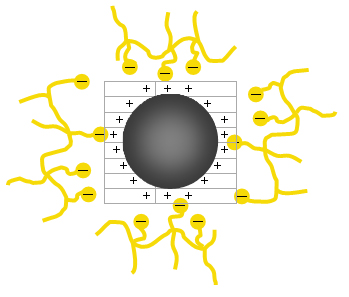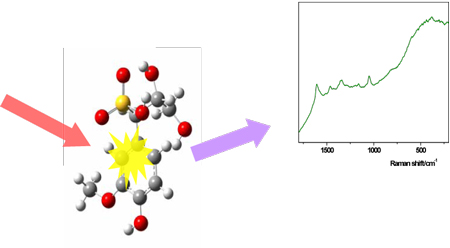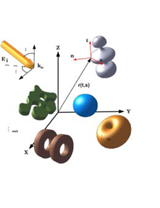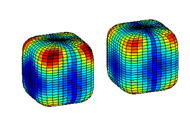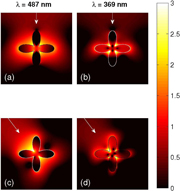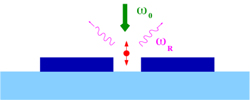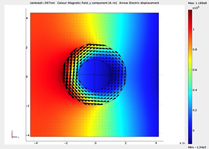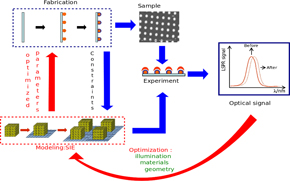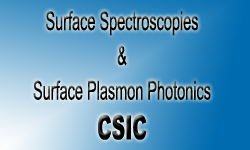 |
 |
| Home | Members | Research Lines | Laboratories | Collaborators | Publications | Openings | Location |
Main Research Lines:
Experimental Research Lines
Nanofabrication
Preparation of metallic plasmonic nanoparticles (NPs) that lead to high electromagnetic field intensification. These substrates were mainly mixed core / shell metal systems, triangular nanoprisms or nanocubes.
Plasmonic substrates with different morphologies of the nanoparticles.
Functionalization of metal surfaces: Nanosensing
The functionalization of metals can significantly increase the sensitivity and selectivity of the nanostructures formed, thus obtaining high-performance surfaces which combine the unique physical properties of plasmonic metals with the chemical properties of organic molecules self-assembled on them.
Functionalization with host or receptor molecules such as calixarenes, cyclodextrins and viologen contaminnates allows the detection of drugs, by the existence of hydrophobic cavities in these hosts, in which can accommodate molecules to be detected.
Detection of pirene by means of surfaces of Ag functionalized with 1,3-bis-(dithiocarbamate) -calix[4]arene.
Functionalization with bifunctional assemblers remarkably improve the performance of the substrate by inducing the creation of interparticle spaces where the electromagnetic field is markedly enhanced (hot spots).
Interparticle spaces formation of high enhancement of electromagnetic field through viologen lucigenine assembly and pirene detection.
Interaction Nanoparticle / Biomolecules
We are studying the adsorption of biomolecules of different nature with metal nanoparticles. Biomolecules studied are oligopeptides, proteins and other natural substances such as humic substances and melanins. In the case of humic substances a characterization was carried out at different pH, and its interaction with pesticides was studied.
Differencial study of humic substance/paraquat complex with different laser excitation lines in the detection of paraquat.
Intensified by plasmonic nanostructures fluorescence (SEF)
SEF technique (Surface-enhanced Fluorescence) on NPs in colloidal suspension has allowed the study of adsorption and aggregation of drugs, especially antitumor drugs hypericin, emodin, and anti-inflammatory drug piroxicam on metal nanoparticles. The interaction of these drugs with albumin results in a consequent increase in the SEF spectra, which together with the SERS spectra, circular dichroism spectra and fluorescence lifetime, have led to important results on the structural changes suffered these systems once adsorbed on the metal surface.
Adsorption model of hypericin, an antitumor drug photosensitive, on surfaces of Ag at different pH.
Ultrasensitive detection of substances used in sports doping
One of the most important applications of the different plasmonic substrates prepared and functionalized in our group is the investigation of the adsorption and detection of substances used in doping, such as b-agonists clenbuterol, salbutamol and terbutaline, as well as aminoglutethimide, an aromatase inhibitor used by athletes to prevent loss of muscle mass. The use of Ag NPs in the shape of triangular prisms has led to significant lowering of the limit of detection of these compounds to levels not yet achieved by conventional techniques.
Detection of aminoglutethimide, an antitumor drug used in sports doping, on plasmonic Au nanoparticles. The detection is sensitive to the different adsorption on the surface with the pH.
Applications in the Cultural Heritage
The implementation of the SEF and SERS techniques to study the pigments of Cultural Heritage was carried out. The presence of plasmonic nanoparticles induces a fluorescence quenching, allowing to observe the Raman bands. We have developed experiments consisting on the laser photoreduction to the in-situ creation of plasmonic nanoparticles for the study and detection of organic pigments in natural fibers without extraction. Specifically, the published results have involved the analysis of yellow pigments such as flavonoids and anthraquinone red pigments in nature, such as alizarin and carmine.
Detection in situ of the flavonoid lutein on silk fibers by means of Ag nanoparticles generation from laser fotorreduction on the fiber.
Within this line of research it has been carried out the application of SERS and SEF spectroscopy to the study of synthetic modern organic pigments. The pigments studied are mainly derived from quinacridone, known for their high durability, in part due to its high insolubility in aqueous media, making it difficult notablemete their characterization by spectroscopic techniques.
Assembly and break up of Quinacridone Quinone pigment by interaction with tetra-carboetoxi-calix[8]arene and ultrasensitive detection on Ag nanoparticles.
Last year we started a new research line to study organic admixtures added to modern and ancient cement and concrete. Admixtures have been added to cement or concrete for the purpose of achieving g a specific modification to the properties. We are studying three types of admixtures: a) suphonate naphthalene formaldehyde-base; b) lignosulphonate-base and c) policarboxilate-base. In general, admixtures have a very complex structure since they are a mix of different compounds. The molecule usually has one apolar group and a polar chain. The latter reacts with cement components. The mechanism of the action of admixtures has not been established with certainty yet.Raman spectra of the admixtures have been obtained and now we are working on the obtention of the SERS spectra; from this dates theoretical studies of the vibrational modes have been analysing in order to elucidate the admixtures structures and to follow structural changes due to molecule and cement components interaction for the purpose of establishing the mechanism of action of chemical admixtures.
Interaction between one particle of cement and polar groups of a superplastic additive.
FT-Raman Spectrum of a lignosulfonate base additive.
NANOPLAS (NANo-Optical PLASmonic antennas)
MICINN Project (FIS2009-11264)
Optical properties of metal nanoparticles: Nanoantennas
Advanced numerical formulation (SIEs+Gielis’ superformula) to study the optical properties of 2D/3D nanoparticles (single or coupled) of arbitrary shape and lack of symmetry. A variety of metal nanoparticles are investigated, thus determining rigorously the localized surface-plasmon resonances of nanocubes, nanostars, nanodimers, etc. The flexibility and reliability of our formulation makes it specially suitable for complex scattering problems in Nano-Optics & Plasmonics.
Left: Electric field intensity on the surface of a Ag rounded-cube dimer (L=30 nm, gap=20 nm) with plane wave illumination matching the longitudinal LSPR. Right: Near-field distributions of the electric field intensities for the Ag four-petal nanoflower with mean radius ρ=30 nm and deformation parameter β=2/3, illuminated with a monochromatic plane wave with wavelength equal to either one of the two main LSPRs (dipolar and quadrupolar, respectively) at λ=487 nm (a,c) and at λ=369 nm (b,d): (a,b) θi=0◦; (c,d) θi=45º.
Nanostructure enhanced Raman/Fluorescence/Photoluminescence
Electromagnetic processes stemming from molecular (spontaneous) emission close to complex metal nanostructures pumped at/near surface-plasmon resonances are investigated. On the one hand, the impact of such resonances on surface-enhanced Raman scattering (SERS) of molecules adsorbed on the nanoantenna surface is addressed through near-field calculations at hot spots. On the other hand, single molecule fluorescence (and/or quantum dot emission) close to metallic nanoantennas is thoroughly, addressing crucial issues as the modification and enhancement (or quenching) of spontaneous emission in (bio)molecular and optoelectronic systems, due to the strong impact on the local (near-field) EM density of states of surface-plasmon resonances in dimer nanoantennas.
EMET(Engineering METamaterials)
CONSOLIDER-INGENIO Proyect (CSD2008-00066)
Metamaterials towards the IR-visible.
We investigate theoretically isotropic metamaterials made up of meta-atoms with high index of refraction in the (IR-)visible range. To this end, core-shell nanostructures will be addressed based on dielectric materials with high, positive index of refración (Si, Ge). Designs based on other geometries, such as nano/micro-wires will be investigated too.
Homogenization methods
We expect to develop numerical techniques based on homogenization methods which in turn take advantage of the power and versatility of the our 3D SIE scattering formulation.
Engineering of plasmonic sensors bio-inspired optimization methods.
This project aims at applying bio-inspired optimization strategies to the optical modeling of complex nanostructures. We intend to generalize our approach to study common-interest applications such as plasmon-assisted chemo- or biosensing. Our start point will be the already implemented 3D surface-integral equation formulation (formally exact) for unsupported nanoparticles of arbitrary shape. This project is a joint venture initiated in 2009 between the group headed by Demetrio Macías at the Institut Charles Delaunay-Laboratoire de Nanotechnologie et d’Instrumentation (UTT, Troyes, France), and our theoretical group.
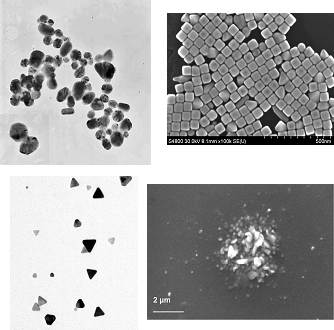
![Detection of pirene by means of surfaces of Ag functionalized with 1,3-bis-(dithiocarbamate)calix[4]arene. Detection of pirene by means of surfaces of Ag functionalized with 1,3-bis-(dithiocarbamate)calix[4]arene.](fotos/calix_s.jpg)
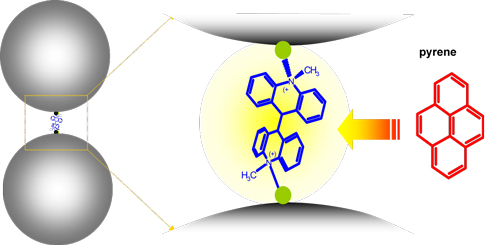
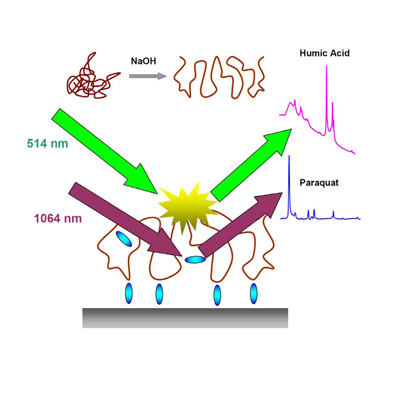
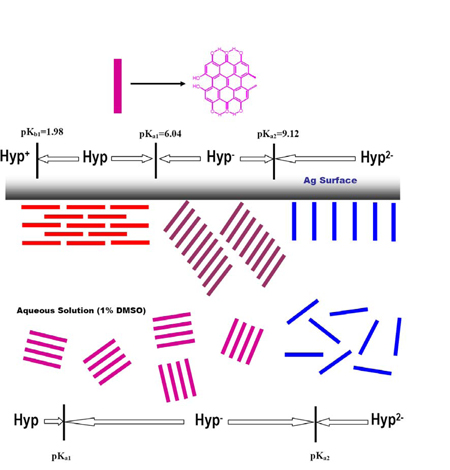
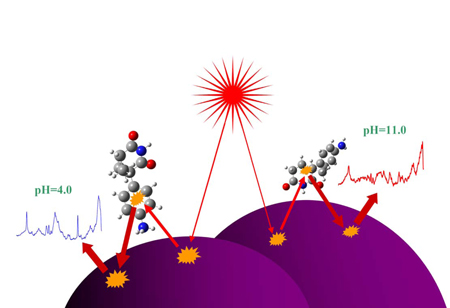
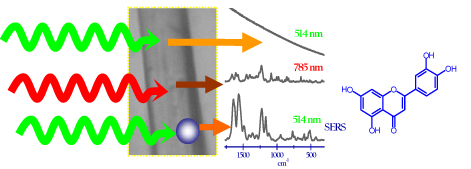
![Assembly and break up of Quinacridone pigment by interaction with tetra-carboetoxi-calix[8]arene and ultrasensitive detection on Ag nanoparticles. Assembly and break up of Quinacridone pigment by interaction with tetra-carboetoxi-calix[8]arene and ultrasensitive detection on Ag nanoparticles.](fotos/quinacr_s.jpg)
